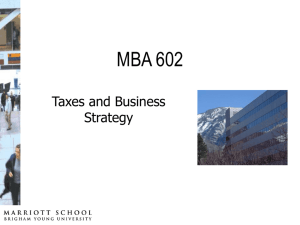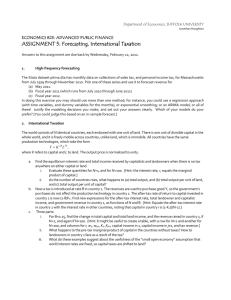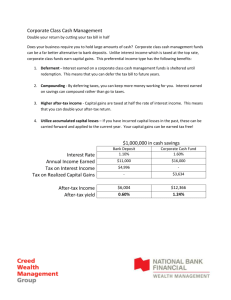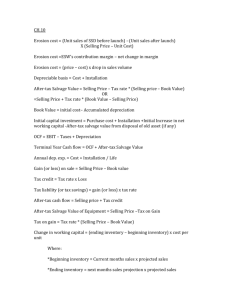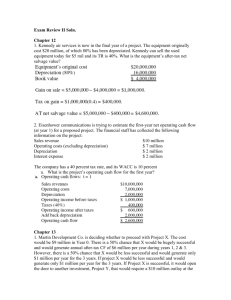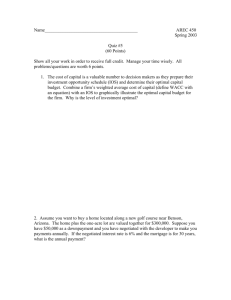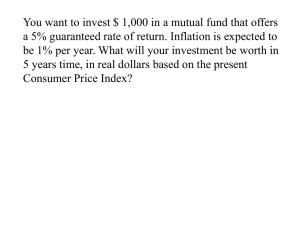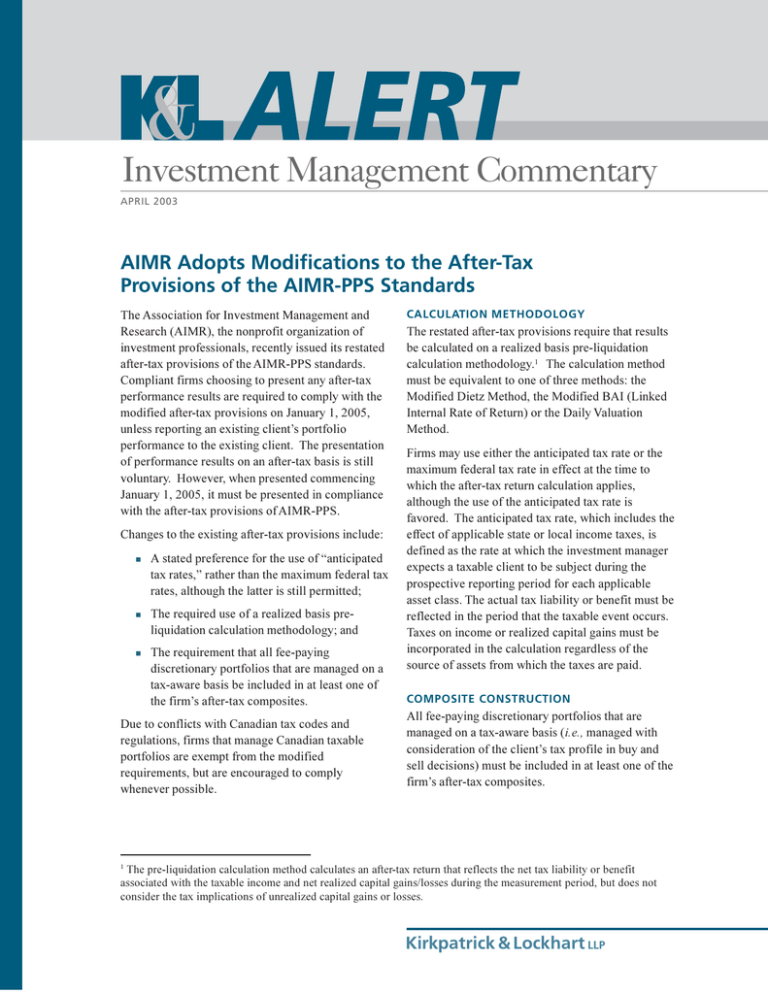
Investment Management Commentary
APRIL 2003
AIMR Adopts Modifications to the After-Tax
Provisions of the AIMR-PPS Standards
The Association for Investment Management and
Research (AIMR), the nonprofit organization of
investment professionals, recently issued its restated
after-tax provisions of the AIMR-PPS standards.
Compliant firms choosing to present any after-tax
performance results are required to comply with the
modified after-tax provisions on January 1, 2005,
unless reporting an existing clients portfolio
performance to the existing client. The presentation
of performance results on an after-tax basis is still
voluntary. However, when presented commencing
January 1, 2005, it must be presented in compliance
with the after-tax provisions of AIMR-PPS.
Changes to the existing after-tax provisions include:
n
n
n
A stated preference for the use of anticipated
tax rates, rather than the maximum federal tax
rates, although the latter is still permitted;
The required use of a realized basis preliquidation calculation methodology; and
The requirement that all fee-paying
discretionary portfolios that are managed on a
tax-aware basis be included in at least one of
the firms after-tax composites.
Due to conflicts with Canadian tax codes and
regulations, firms that manage Canadian taxable
portfolios are exempt from the modified
requirements, but are encouraged to comply
whenever possible.
CALCULATION METHODOLOGY
The restated after-tax provisions require that results
be calculated on a realized basis pre-liquidation
calculation methodology.1 The calculation method
must be equivalent to one of three methods: the
Modified Dietz Method, the Modified BAI (Linked
Internal Rate of Return) or the Daily Valuation
Method.
Firms may use either the anticipated tax rate or the
maximum federal tax rate in effect at the time to
which the after-tax return calculation applies,
although the use of the anticipated tax rate is
favored. The anticipated tax rate, which includes the
effect of applicable state or local income taxes, is
defined as the rate at which the investment manager
expects a taxable client to be subject during the
prospective reporting period for each applicable
asset class. The actual tax liability or benefit must be
reflected in the period that the taxable event occurs.
Taxes on income or realized capital gains must be
incorporated in the calculation regardless of the
source of assets from which the taxes are paid.
COMPOSITE CONSTRUCTION
All fee-paying discretionary portfolios that are
managed on a tax-aware basis (i.e., managed with
consideration of the clients tax profile in buy and
sell decisions) must be included in at least one of the
firms after-tax composites.
1
The pre-liquidation calculation method calculates an after-tax return that reflects the net tax liability or benefit
associated with the taxable income and net realized capital gains/losses during the measurement period, but does not
consider the tax implications of unrealized capital gains or losses.
Kirkpatrick & Lockhart LLP
If a firms before-tax composite includes a broad set
of portfolios (i.e., tax-exempt portfolios, portfolios
that are managed on a tax-aware basis, and portfolios
that are not managed to consider taxes), the firm may
need to segregate the portfolios into smaller after-tax
composites that take into account the clients different
tax structures and risk tolerances.
includes both taxable and tax-exempt
portfolios;
n
n
DISCLOSURES
If a firm claiming compliance with the AIMR-PPS
standards chooses to report after-tax performance
results to an existing client, the firm may disclose
that the clients returns were calculated in accordance
with the after-tax calculation methodology
referenced previously. Firms making this claim are
required to include the following disclosure:
The after-tax returns shown are subject to
the limitations of the specific calculation
methodology applied. Since the clients
actual circumstances and tax rates
determined after the fact may differ from
the anticipated tax rates used in this
process, the reported returns may not equal
the actual after-tax returns for specific
clients.
n
n
n
n
The accounting convention used for
determining the cost basis of the securities held
by the portfolios, including (but not limited to)
highest cost, lowest cost, FIFO, LIFO, and
specific identification;
The after-tax composite as a percentage of the
taxable portfolios that is included in the
applicable before-tax composite.
PRESENTATION AND REPORTING
After the after-tax returns are calculated, the
following key presentation and reporting concepts
must be reflected:
n
The after-tax and before-tax composite
presentations, if the before-tax composite from
which the after-tax composite is drawn
A measure of the dispersion of individual
component portfolio returns (calculated the
same for both after-tax and before-tax returns)
around the total composite return on an aftertax and before-tax basis for each annual period
that after-tax returns are presented.
The restated after-tax provisions contain numerous
recommendations, some of which include:
n
n
n
n
The tax rate calculation methodology used for
the composite and for the benchmark;
Identification of the before-tax composite from
which the portfolios comprising the after-tax
composite were drawn; and
The dollar-weighted anticipated tax rate on
ordinary income or the maximum federal tax
rate on interest and dividend income of the
portfolios in the composite; and
RECOMMENDATIONS
The following disclosures are also required under the
restated after-tax performance provisions:
n
As of the end of each reporting period, the
percentage of unrealized capital gains to the
entire after-tax composite assets;
n
Consideration of factors such as client type,
applicable tax rate(s), and vintage year (in
addition to investment objective or style) when
defining after-tax composites;
Presentation of returns as supplemental
information when calculated by a method other
than a pre-liquidation basis, if accompanied by
a list of key assumptions;
Disclosure of the percentage benefit of tax-loss
harvesting if the realized losses are greater than
realized gains for the period;
Inclusion of the amortization of premiums and
accretion of discounts on all bonds in the
accrued interest if required by the clients tax
situation; and
Adjustment of after-tax returns for nondiscretionary capital gains (i.e., gains incurred
because of client-initiated withdrawals).
CONCLUSION
Although the effective date of the modified after-tax
provisions is January 1, 2005, firms are encouraged
to comply with the provisions prior to this date.
Firms are not required to produce a 10-year history
of compliant after-tax returns on the effective date,
but must produce compliant after-tax performance
results annually from the effective date so that by
December 31, 2014, a 10-year record of compliant
after-tax returns is achieved. Non-compliant after-
Kirkpatrick & Lockhart LLP
2
tax performance results may not be linked to after-tax
results that are compliant with either the original
1994 AIMR-PPS after-tax provisions or the restated
after-tax provisions except in the case where they are
presented as supplemental information.
The restated after-tax provisions include detailed
guidance as to how the disclosures should be
calculated and presented, which includes several
examples and applications of the provisions. The
complete after-tax provisions as well as the guidance
may be found on AIMRs website at www.aimr.com.
MICHAEL S. CACCESE*
617.261.3133
mcaccese@kl.com
CHRISTINA H. LIM
617.261.3243
clim@kl.com
* Michael Caccese is a partner in the Boston office of Kirkpatrick & Lockhart LLP. He works extensively with
investment firms on compliance issues, including all of the AIMR standards. He was previously the General Counsel to
AIMR and was responsible for overseeing the development of the AIMR-PPS, GIPS and other standards governing the
investment management profession and investment firms. He can be reached at 617.261.3133 and mcaccese@kl.com.
Christina H. Lim is an associate with K&L in the Boston office and may be reached at 617.261.3243 and clim@kl.com.
Kirkpatrick & Lockhart LLP
3
Kirkpatrick & Lockhart LLP maintains one of the leading investment management practices in the United States,
with over 60 lawyers devoting all or a substantial portion of their practice to this area. According to the April 2002
American Lawyer, K&L is a mutual funds powerhouse that represents more of the largest 25 investment company
complexes and their affiliates than any other law firm.
We represent mutual funds, insurance companies, broker-dealers, investment advisers, retirement plans, banks and
trust companies, hedge funds, offshore funds and other financial institutions. We also regularly represent mutual
fund distributors, independent directors of investment companies, retirement plans and service providers to the
investment management industry. In addition, we frequently serve as outside counsel to industry associations on a
variety of projects, including legislative and policy matters.
We work with clients in connection with the full range of investment company industry products and activities,
including all types of open-end and closed-end investment companies, funds of hedge funds, variable insurance
products, private and offshore investment funds and unit investment trusts. Our practice involves all aspects of the
investment company business: from organizing and registering open-end and closed-end funds, both as series and
individual portfolios, to providing ongoing advice and representation to the funds and their advisers, directors and
distributors.
We invite you to contact one of the members of our investment management practice, listed below, for additional
assistance. You may also visit our website at www.kl.com for more information, or send general inquiries via email
to investmentmanagement@kl.com.
BOSTON
Michael S. Caccese
Philip J. Fina
Mark P. Goshko
Thomas Hickey III
Nicholas S. Hodge
617.261.3133
617.261.3156
617.261.3163
617.261.3208
617.261.3210
mcaccese@kl.com
pfina@kl.com
mgoshko@kl.com
thickey@kl.com
nhodge@kl.com
LOS ANGELES
William P. Wade
310.552.5071
wwade@kl.com
NEW YORK
Beth R. Kramer
Richard D. Marshall
Robert M. McLaughlin
Loren Schechter
212.536.4024
212.536.3941
212.536.3924
212.536.4008
bkramer@kl.com
rmarshall@kl.com
rmclaughlin@kl.com
lschechter@kl.com
SAN FRANCISCO
Eilleen M. Clavere
Jonathan D. Joseph
David Mishel
Mark D. Perlow
Richard M. Phillips
415.249.1047
415.249.1012
415.249.1015
415.249.1070
415.249.1010
eclavere@kl.com
jjoseph@kl.com
dmishel@kl.com
mperlow@kl.com
rphillips@kl.com
WASHINGTON
Clifford J. Alexander
Diane E. Ambler
Catherine S. Bardsley
Arthur J. Brown
Arthur C. Delibert
Robert C. Hacker
Benjamin J. Haskin
Kathy Kresch Ingber
Rebecca H. Laird
Thomas M. Leahey
Cary J. Meer
R. Charles Miller
Dean E. Miller
R. Darrell Mounts
C. Dirk Peterson
Alan C. Porter
Theodore L. Press
Robert H. Rosenblum
William A. Schmidt
Lynn A. Schweinfurth
Donald W. Smith
Robert A. Wittie
Robert J. Zutz
202.778.9068
202.778.9886
202.778.9289
202.778.9046
202.778.9042
202.778.9016
202.778.9369
202.778.9015
202.778.9038
202.778.9082
202.778.9107
202.778.9372
202.778.9371
202.778.9298
202.778.9324
202.778.9186
202.778.9025
202.778.9464
202.778.9373
202.778.9876
202.778.9079
202.778.9066
202.778.9059
calexander@kl.com
dambler@kl.com
cbardsley@kl.com
abrown@kl.com
adelibert@kl.com
rhacker@kl.com
bhaskin@kl.com
kingber@kl.com
rlaird@kl.com
tleahey@kl.com
cmeer@kl.com
cmiller@kl.com
dmiller@kl.com
dmounts@kl.com
dpeterson@kl.com
aporter@kl.com
tpress@kl.com
rrosenblum@kl.com
william.schmidt@kl.com
lschweinfurth@kl.com
dsmith@kl.com
rwittie@kl.com
rzutz@kl.com
®
Kirkpatrick & Lockhart LLP
®
Challenge us.
www.kl.com
BOSTON
n
DALLAS
n
HARRISBURG
n
LOS ANGELES
n
MIAMI
n
NEWARK
n
NEW YORK
n
PITTSBURGH
n
SAN FRANCISCO
n
WASHINGTON
............................................................................................................................................................
This publication/newsletter is for informational purposes and does not contain or convey legal advice. The information herein
should not be used or relied upon in regard to any particular facts or circumstances without first consulting a lawyer.
© 2003 KIRKPATRICK & LOCKHART LLP.
ALL RIGHTS RESERVED.

